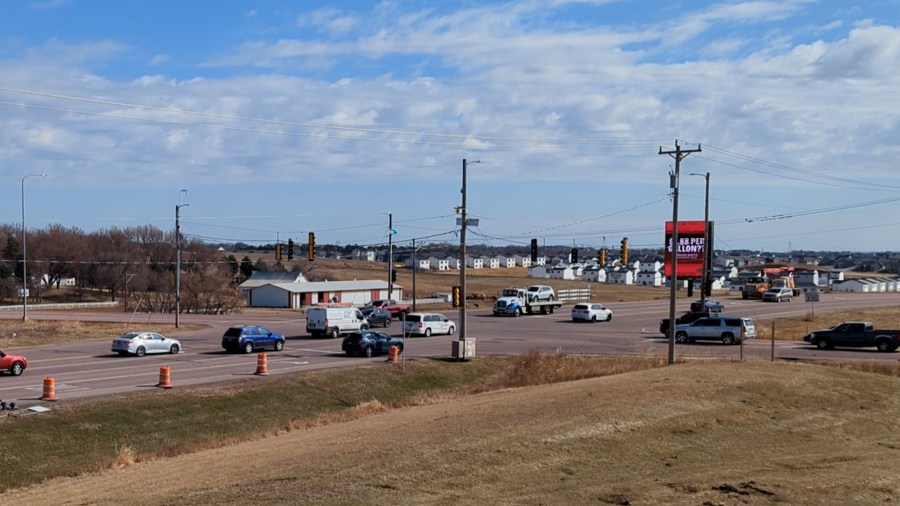SIOUX FALLS, S.D. (KELO) — Construction on a major road project is about to begin in Sioux Falls, with the end goal being the largest intersection in the state of South Dakota.
Presently, the City of Sioux Falls says around 33,000 vehicles travel through the intersection daily, moving along both Arrowhead and Veterans Parkway. By 2045, the city expects that daily count to hit 55,000.
“Starting tomorrow, we’re going to be reconstructing the intersection of Arrowhead Parkway and Veterans Parkway,” said Sioux Falls Principal Engineer Brad Ludens. “We’re going to be doing a lot of underground utility work. We’re going to be reconstructing and widening the roadway. It ultimately will be three lanes in each direction at the intersection, with dual left turn lanes and a right turn lane on each leg.”
In addition to these lane additions, Ludens says the project will also add three pedestrian underpasses in addition to the traditional crosswalks at road level.
The project will last long, and will see extensive traffic impacts.
“It’s going to be a two year project,” said Ludens. “Starting Monday morning, we’re going to be closing the east side of the intersection from just east of Veterans Parkway, all the way down to 10th Street.”
This section will remain closed throughout the 2025 construction season, said Ludens.
Arrowhead Parkway west of Veterans Parkway will remain open, and Veterans Parkway will have one lane open in each direction through the summer and into the fall, said Ludens.
Ludens does warn that for one week in the fall, they will have to fully close Veterans Parkway to do a transition. There will also be one week in fall where Arrowhead west of Veterans Parkway will be closed for a similar transition.
“Then in the spring of 2026, you’ll kind of see a mirror image of what’s happening this year,” Ludens said. “Well, we’ll close the west side of the intersection and build everything from Veterans to Highline Avenue.”
“All lanes will be fully open to traffic in the fall of 2026,” said Ludens, though he noted that there may be some lane closures in the spring of 2027 as they do clean up and cosmetic work.
Currently, Veterans Parkway is four lanes to the north and south of Arrowhead Parkway, but where it crosses Arrowhead, it restricts down to one lane in each direction, with two turning lanes on the north side, and one on the south side, with the northbound lane doubling as the right turn lane onto Arrowhead.
“There’s a lot of traffic backup on Veterans during peak traffic times,” said Ludens. “Even on Arrowhead, there’s just a lot of traffic that’s coming from the east in the morning and heading back out that way in the afternoon.”
Part of the importance in expanding this intersection is the role it will play in the Veterans Parkway corridor. “This is a major intersection in that Veterans Parkway corridor that will stretch from I-90 all the way down to I-29 when it’s all said and done,” Ludens said.
With Arrowhead closed completely east of Veterans Parkway, Ludens says the major detour routes will be Madison Avenue, Six Mile Road and 41st Street. Sycamore Avenue will also be a main route.
Ludens says in some areas along these routes, such as at 26th and Six Mile Road, the city has added temporary traffic signals to ease traffic impacts.
“We’ll be monitoring the traffic in those areas and making adjustments to those traffic signals’ timing as we need to in order to help get everyone to where they need to go,” Ludens said.
While Ludens says the city will be doing its best to address traffic on its end, he urges commuters to do so as well. “Leave a few minutes early, you know, go slow,” he said. Stay off your phones — be distraction free as you are driving through construction zones — just be careful.”
Though the closure to Arrowhead is scheduled for Monday, Ludens says drivers should expect a traffic impact beginning on Wednesday the 26th, and asks them to begin using the detours on Wednesday as well.
“We’re just going to ask people to just assume that Arrowhead Parkway will be closed east of Veterans Parkway,” said Ludens. “There’s going to be a lot of crews out setting up signs, setting up barricades — if someone were to sneak through in the morning, you’re not going to be able to in the afternoon.”


